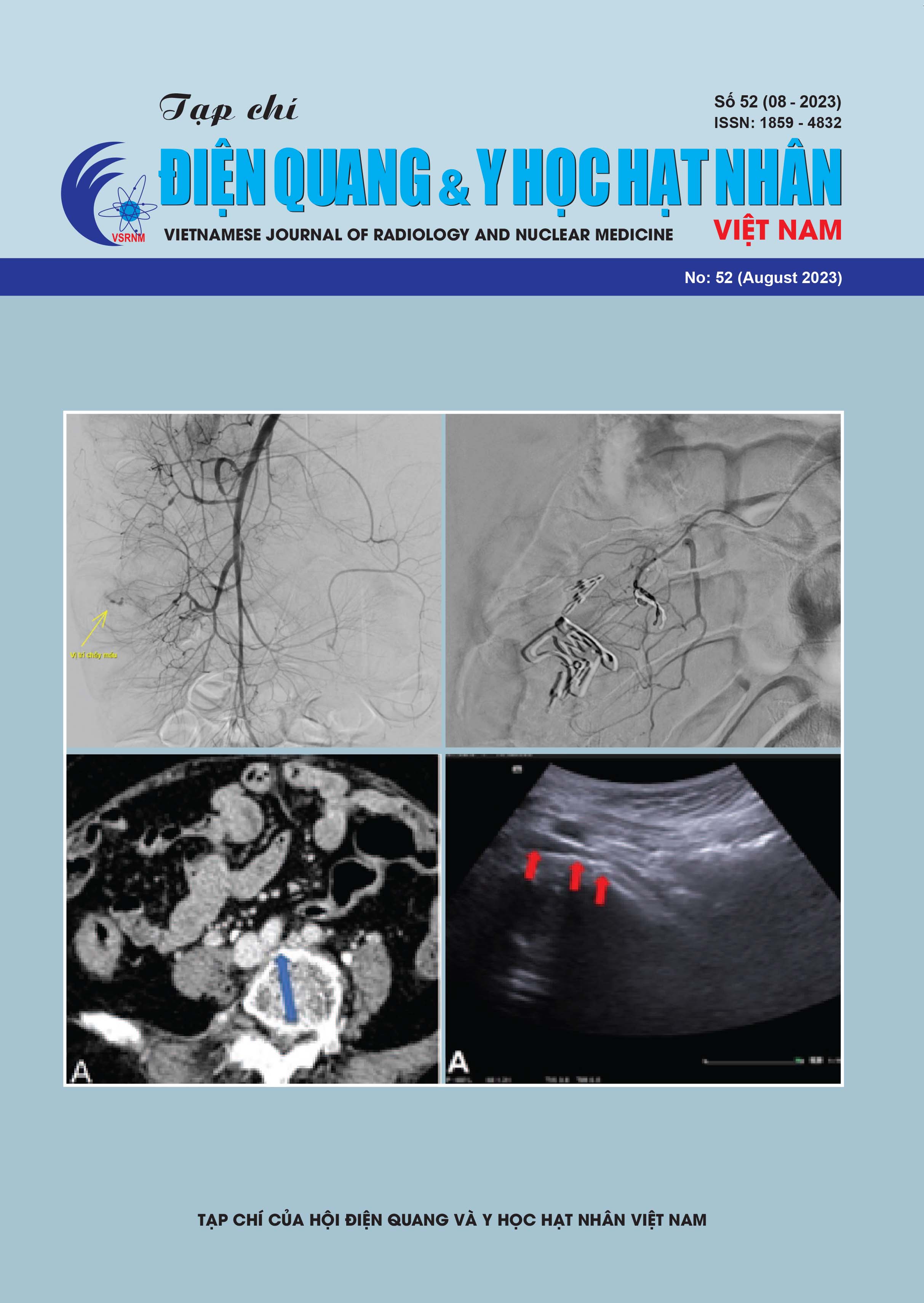Imaging characteristics and the role of whole body multidetector computed tomography in patients with stage IV prostate cancer
Main Article Content
Abstract
Purpose: The study was conducted to describe image characteristics of prostate cancer on multidetector computed tomography (MDCT) and to determine the role of MDCT in patients with stage IV prostate cancer.
Objectives and subjects: A cross-sectional study was performed on 45 patients at Huu Nghi Hospital from January 2017 to May 2023. All patients had pathologically proven prostate cancer, multi-parameter magnetic resonance imaging (mp-MRI), MDCT, and bone scan and were categorized as stage IV.
Results: The mean age was 78.31±5.64 years, mean Total prostatespecific antigen (tPSA) concentration was 279.78 ng/ml, mean prostate volume was 45.20 ml. 60% of patients had extra-prostatic invasion, 66.7% had regional lymph node metastases; 40% of patients had distant lymph node metastasis; 46.7% had bone metastasis; 28.9% had distant metastasis to other organs. MDCT had good to very good concordance with MRI in evaluating local invasion and good concordance with bone scintigraphy in evaluating bone metastasis, with p <0.05.
Conclusion: MDCT had a high value in assessing metastatic lesions in patients with stage IV prostate cancer, especially lung lesions. Whole-body MDCT is a useful alternative to MRI and PET/CT in evaluating metastatic lesions from prostate cancer.
Article Details
Keywords
Prostate cancer, Multidetector computerized tomography, bone scintigraphy.
References
2. Resnick M. J., Koyama T., Fan K. H., et al. Long-term functional outcomes after treatment for localized prostate cancer. N Engl J Med. 2013;368:436-445.
3. Chen W., Zheng R., Baade P. D., et al. Cancer statistics in China, 2015. CA: a cancer journal for clinicians. 2016;66(2):115-132.
4. Mottet N., Bellmunt J., Bolla M., et al. EAU-ESTRO-SIOG guidelines on prostate cancer. Part 1: screening, diagnosis, and local treatment with curative intent. European urology. 2017;71(4):618-629.
5. Schiavina R., Chessa F., Borghesi M., et al. State-of-the-art imaging techniques in the management of preoperative staging and re‐staging of prostate cancer. International Journal of Urology. 2019;26(1):18-30.
6. Pesapane F., Czarniecki M., Suter M. B., et al. Imaging of distant metastases of prostate cancer. Medical Oncology. 2018;35(11):1-17.
7. Rosenkrantz A. (Ed.). MRI of the Prostate: A Practical Approach. Thieme. 2016.
8. Buyyounouski M. K., Choyke P. L., McKenney J. K., et al. Prostate cancer–major changes in the American Joint Committee on Cancer eighth edition cancer staging manual. CA: a cancer journal for clinicians. 2017;67(3):245-253.
9. Gandaglia G., Abdollah F., Schiffmann J., et al. Distribution of metastatic sites in patients with prostate cancer: a population‐based analysis. The Prostate. 2014;74(2):210-216.
10. Lê Thị Khánh Tâm. Đánh giá kết quả điều trị nội tiết ung thư tuyến tiền liệt giai đoạn IV. Luận án Tiến sỹ. Trường Đại học Y Hà Nội; 2020. 11. Bubendorf L., Schöpfer A., Wagner U., et al. Metastatic patterns of prostate cancer: an autopsy study of 1,589 patients. Human Pathology. 2000;31(5):578-583.
12. Engeler C. E., Wasserman N. F., Zhang G. Preoperative assessment of prostatic carcinoma by computerized tomography: Weaknesses and new perspectives. Urology. 1992;40(4):346-350.
13. Tanimoto A., Nakashima J., Kohno H., et al. Prostate cancer screening: the clinical value of diffusion-weighted imaging and dynamic MR imaging in combination with T2-weighted imaging. Journal of Magnetic Resonance Imaging: An Official Journal of the International Society for Magnetic Resonance in Medicine. 2007;25(1):146-152.
14. Zhang J. Computed tomography imaging in patients with prostate cancer. In: Hricak H, Scardino P, eds. Prostate cancer. Cambridge University Press; 2009:120 - 139:chap 8.


